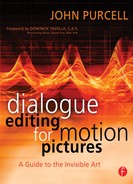Foreword
I really like this book.
But, I am getting ahead of myself.
To begin, I am a rerecording engineer, more commonly known as a mixer. My job is to take all of the assorted sounds—dialogue, sound effects, music, Foleys—that have been painstakingly assembled for the film’s track and create a final, smooth, and hopefully moving and emotional soundtrack that you will hear in the theater or on your TV.
I’ve been doing it for some thirty years now, and I’ve mixed just about every kind of film or video you can imagine, from student films to big-budget studio features, commercials, video games, documentaries, on and on. One thing that I have learned through all of this is that in any kind of project, every word is important. The loss of a single word in a sentence, sometimes a single syllable, can make the entire sentence unintelligible. Worse still, it can often cause the loss of the next few sentences as the odd audience member furrows his brow and says, “What did she say?”
This brings us to this book’s subject, dialogue editing. The job of the dialogue editor is to make every single word as clear as possible. He or she has to remove any and all distractions, noises, or mumbles to make the words as clear as a bell. All of this preparation of the myriad bits and pieces of production sound and ADR is for the mix, that is, for me. Since my time is quite expensive and, usually limited, everyone wants me to spend as little time as possible fixing dialogue problems, and most of my time making it sound beautiful. Remember, every word is important!
This is why I think that dialogue editing is usually the most important part of preparing for a mix. I find it ironic that if the work is done well—if the dialogue sounds clean and natural—the dialogue editor’s work is usually invisible. Directors and editors expect to hear the words they heard on the set and in the cutting room. It’s very easy to take notice of added sound effects, or Foleys, or music, because these things are added after the fact; they are embellishments, icing. But the dialogue editing is often not noticed unless there is a problem. Great dialogue editing is invisible, but its importance cannot be overstressed. Remember, every word is important!
This book is filled with lots of useful information and advice, but there are a few things that I particularly like about it. I like how John stresses the human factor. The interactions among the different editorial departments, and even among your own crew, can often make the difference between a great job and a lousy one. Listen to him on this.
Another thing I like is this author’s approach to the “rules” of editing. If you ask just about any true craftsperson—editor, plumber, designer, or carpenter—he or she will tell you that each job is unique. There may be general approaches to solving a particular dilemma, but each job, even each element of a job, will have different needs from the last one. You have to listen to the work; it will tell you what it wants. John knows this.
So, this is more than a “how-to” book, as it should be. It’s also a “why” book. The technical part of any of the film crafts, though daunting, is the easiest to teach. It is much more difficult to explain the subtleties, the “feeling” of when it’s right, the elusive search for why it’s wrong. This is the agonizing, keepyou-up-at-night part of the job. John does a great job of describing this, and his passion shines through.
As filmmakers, we are creating an artificial world, and asking an audience to pretend along with us for a couple of hours. This is a fragile construct, and we have to be careful to never show the process, never break the illusion of a real space in a real world, by inadvertently revealing the details behind the facade. The dialogue has to be as perfect as we can make it, or we risk losing the audience.
I really like this book. I think every aspiring, or practicing, editor can find a lot of good in these pages. Heck, even I learned a lot.
So enjoy this book, and remember, it’s a map, not a turn-by-turn set of instructions. It should help you find your own way. Enjoy the journey, and I’ll see you at the movies.
Dominick Tavella
Note: Dominick Tavella mixes films in New York. Among his many works are Romance & Cigarettes, State and Main, Chocolat, Far and Away, The Royal Tenenbaums, and Vanity Fair. He received an Oscar® and a BAFTA Award for his work on Chicago.
